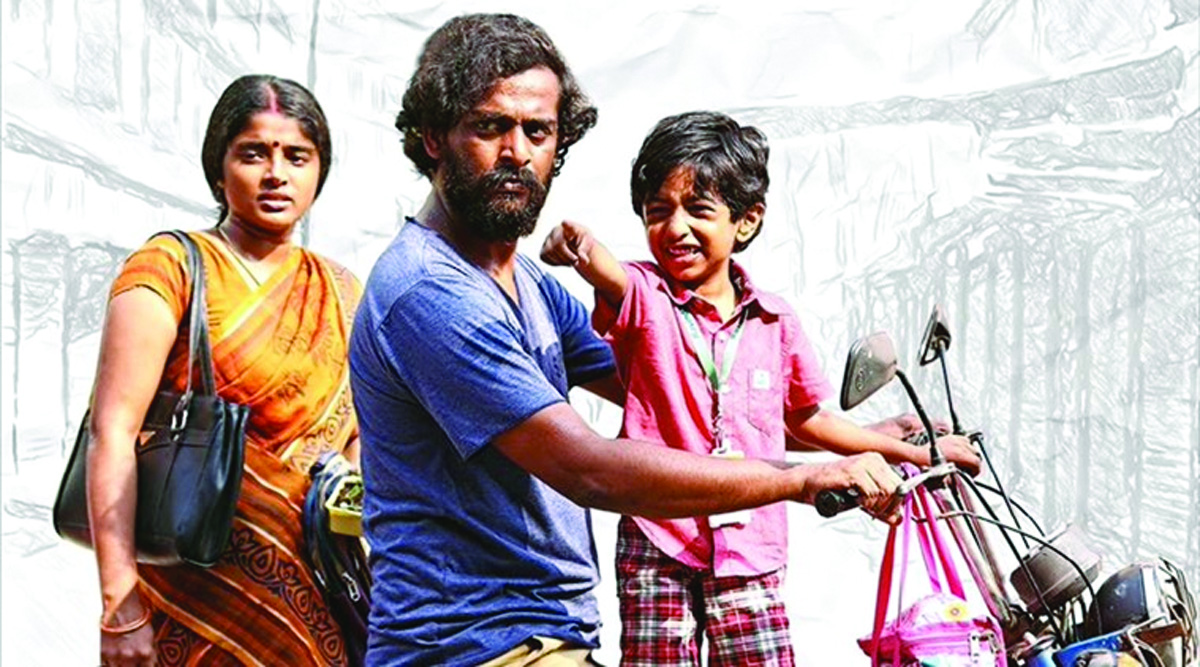‘To Let’ Movie Review: Authentic Bittersweet Family Drama of Mundane Survival

‘To Let’ movie review: Chezhiyan weaves a poignant human fiction with a laser-sharp focus.
Cast: Santhosh Sreeram, Sheela Rajkumar, Dharun Bala
Director: Chezhiyan
Rating: 4 stars
Mildly-lit rooms. Crayon scribbles on the walls. A nightie-clad woman tuning into a radio station. A lungi-clad man trying to unclog the toilet. We get a glimpse into the lives of an aspiring filmmaker Ilango (Santhosh Sreeram), his wife Amudha (Sheela) and their son Siddharth (Dharun). While most films build up to hero-introduction shots in the beginning, To Let builds up to a lower-middle-class family that does the mundane things.
Ilango and Amudha have their intimate moment and we hear “Oru Iniya Manadhu” from Johnny play on the radio. Then, she thanks Ilango for taking her out. She also yells at him, “Can’t you even make dosas properly?” You know Amudha loves Ilango. At the same time, she is unhappy with the way he runs the family. It is not that they are poor. They are struggling with whatever little they had.
Like any other housewife, she cribs about not having enough money to meet the monthly errands. What does Ilango do? He pays attention to Amudha, but he pays more attention to the Russian film that plays on television.
Chezhiyan, a former associate of veteran lensman PC Sreeram, captures all that so vividly and transports you into the couple’s world.
Suddenly, one day, they are asked to vacate the house. Ilango starts searching for another rented space. Chezhiyan takes us through the issues that most of us would have faced at some point in time. The landlords question him, “Which caste do you belong to?”, “Are you a vegetarian?”, “Do you believe in God or are you an atheist?” and so on.
To Let, throughout, reminded me of Balu Mahendra’s Veedu (1988), which revolves around a similar theme. But Veedu, at least, had Ilaiyaraaja’s terrific background score unlike this one—that has no music director. Chezhiyan had managed to fill the film with ambient noise—chirping of the birds, the sound of mopeds and grinders. The filmmaker’s perspective isn’t bound by cliches to simply highlight the situation, but he weaves a poignant human fiction with a laser-sharp focus. To Let is Chezhiyan’s sincere attempt to tell a story in the most realistic way. Hence, it comes as no surprise that it won the National Award under the Best Tamil Film category.
Four-year-old Siddharth loves scribbling on the walls, but doesn’t realise it’s not something that can be done in a rented house. Amudha gets frustrated and asks Siddharth to erase them all.
Eventually, Amudha and Ilango go in search of houses, and Siddharth asks Ilango, “We have everything, which is ours; but why is the house in which we stay alone, not ours?” Meanwhile, watch out for Siddharth’s expressions which are endearing.
In another scene, Siddharth invites Amudha and Ilango for a game that involves, guess what? – ‘house-hunting’. It is interesting how this kid is shown being painfully aware of his parents’ situation. In particular, I enjoyed how the scene was written and shot.
‘To Let’ is just not about Amudha and Ilango hunting for a house and their economic life, but also partially explores unfair practices in the film industry.
As one of the characters rightly says, “Cinema kaarana nambi naataiye kudupom, aana veedu kudukka maatom.” (You trust cinema folk and let them rule the country, but you don’t give them a house).
— S Subhakeerthana in Indian Express.
